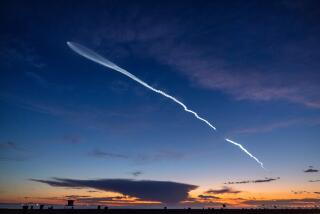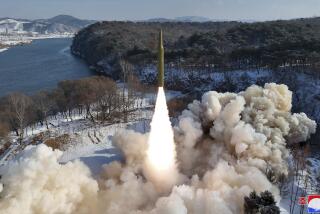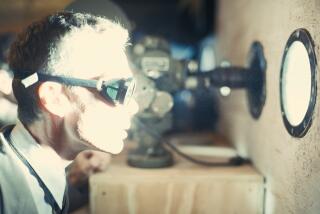U.S., Soviet Scientists Call Blast Tests a Success
- Share via
DEEP SPRINGS, Calif. — Evgeni P. Velikhov, a top arms control adviser to Soviet leader Mikhail S. Gorbachev, somberly studied an erratic seismograph, then allowed himself an impish grin.
“Ah,” he teased several American observers standing next to him. “The Soviets are watching.”
The Soviets were indeed watching Saturday, using seismic monitoring devices to detect and classify a relatively small blast of conventional explosives detonated 130 miles away in the Nevada desert near Broken Hills.
Soviet and American scientists involved in the experiment said it indicates that modern, supersensitive equipment can be used to verify a comprehensive nuclear test ban treaty being discussed by the two nations.
Second Day of Detections
It was the second day in a row that the Soviet and American scientists were able to detect such explosions, and Velikhov, vice president of the Soviet Academy of Sciences, was pleased.
“It’s a very good reading,” he said, sharing a seismograph with about 40 people who had come to witness the experiment in a trailer on a hill near this desolate town, 90 miles north of Death Valley.
The two-day experiment was designed to determine how well high-frequency seismic waves travel through Nevada’s highly fractured geology.
Geologists have for years measured low-frequency seismic waves over great distances. John Adams, executive director of the Natural Resources Defense Council, an environmental group spending $3 million to co-sponsor the experiment with the Soviet Academy of Sciences, likened it to thumping bass notes from a neighbor’s noisy radio.
But scientists here said relying on low-frequency seismic waves makes it difficult to distinguish a nuclear test from an earthquake or a conventional explosion at a mine or building site. Adams said it is the same as trying to identify a melody by listening only to its bass notes.
By adding the rest of the musical scale, a song can be more easily recognized--and, he said, a “seismic event” can be categorized by charting its high-frequency waves as well as its low-frequency waves.
However, high-frequency waves do not move through the Earth’s crust as well as low-frequency waves. Only with the latest technology can these waves be accurately measured over long distances, the scientists here said.
Just how distant the waves can be accurately measured in Nevada is what the Soviet and American scientists came to study. Last year, the scientists found that the solid granite bedrock under the Soviet nuclear test site in Kazakhstan lets high-frequency waves be measured at least 400 miles away.
Tests Friday and Saturday indicate that the highly tectonic, or cracked, subsurface geology of Nevada limits the detection of such seismic waves to about 250 miles.
Thomas B. Cochran, co-director of the project, said the results indicate “it is going to be tougher for the Russians than it would be for the Americans to monitor a comprehensive test ban.”
Detailed conclusions about the tests will have to wait for a more complete analysis of the more than 150 seismic monitors used to measure the tests. These monitors include several brought by Soviet scientists for use in the sparsely inhabited desert 120 miles west of the Nevada Test Site used by the U.S. government to test nuclear weapons.
Organizers said it is the first test of its kind ever open to Soviet scientists using their own equipment.
On Saturday, the experiment started with a bang--literally. At 11 a.m., a ton of Tovan--a pasty pink explosive--was detonated in each of 10 holes bored 160 feet into the isolated and desolate Black Rock Desert 150 miles notheast of Reno. As the simultaneous blasts pushed black dirt and ground water in the air, they also shook the Earth under several dozen observers gathered nearby.
More importantly, scientists said Soviet and American detectors sensed it here as did American equipment at another monitoring station at Troy Canyon 260 miles from the blast. Scientists at a third major station at Nelson 430 miles away said they did not detect the explosion.
Linked by Satellite
The three stations, which are operated by and linked by satellite to UC San Diego, registered a second blast Friday evening in southern Nevada and the third blast Saturday at noon midway between the others.
“The signals we recorded are about the size we would have expected,” said Charles Archambeau, a University of Colorado geophysics professor who heads the Natural Resources Defense Council’s seismic monitoring advisory committee.
The test explosions, with the power of 10 tons or 15 tons of TNT, were only about 1% as powerful as the one-kiloton (1,000-ton) explosion that scientists affiliated with this test consider the minimum needed for a successful nuclear test. This, they said, shows that their system allows for a verifiable ban on all nuclear tests--even those held in underground caverns to mask the size of the bomb being tested.
Washington has been ambivalent toward the tests. Americans and Soviets affiliated with the tests note that visas for the Soviet scientists were delayed nearly a year, that the Reagan Administration has shown little official interest in the tests’ results, and that only minimal government cooperation was offered.
Nikolai Yukhnin, a geophysicist and leading technician among the 15-member Soviet delegation, said detailed geological workup has an “immediate and direct” impact on his country’s willingness to discuss a more comprehensive nuclear test ban.
More to Read
Sign up for Essential California
The most important California stories and recommendations in your inbox every morning.
You may occasionally receive promotional content from the Los Angeles Times.










